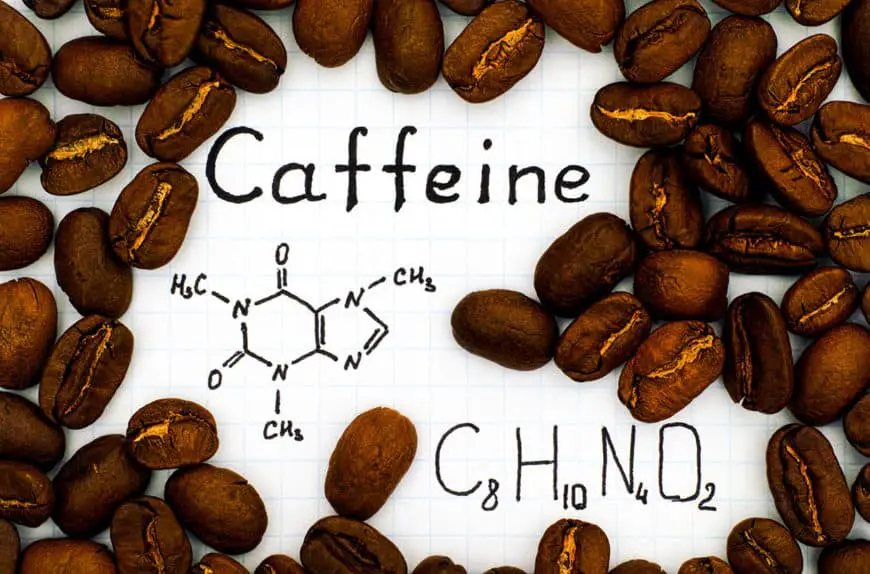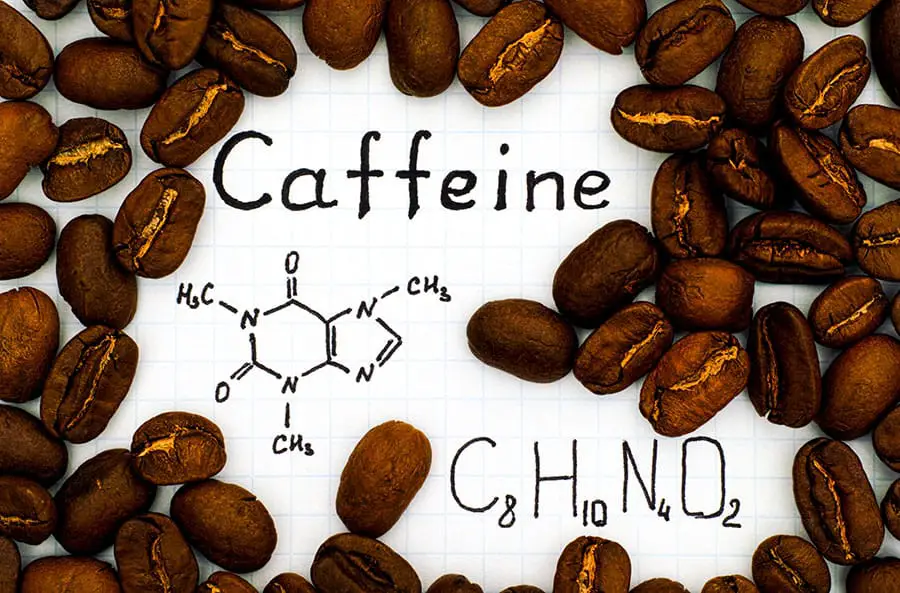
Most people drink a morning cup of coffee without really giving it much thought in the hopes that they will get a small burst of energy to get through a long day of school or work. But what about the caffeine and how much actually is their in the average cup of coffee?
It turns out that certain coffee drinks are much more highly caffeinated than others. What kinds of coffee pack the hardest caffeinated punch, and what kinds will leave you sleepy halfway through the day? That’s what we’ll be focusing on in this post, as we explore everything to do with the amount of caffeine in a cup of coffee.
How Much Caffeine is in a Cup of Coffee?
The amount of caffeine in a cup of coffee varies depending on the type of coffee, the serving size, and the brewing method. On average, an 8-ounce (240 mL) cup of brewed coffee contains about 95 milligrams of caffeine.
However, this amount can range from 40-165 milligrams for a single serving. Factors such as the type of coffee bean, roast level, and grind size can affect the caffeine content, as well as the brewing time and method. Instant coffee typically contains less caffeine compared to freshly brewed coffee, while espresso shots contain more caffeine per serving.
Lets look at a chart of the different types of coffee drinks and how much caffeine is in each one of them so can we have a guide to go by as we discuss this topic. I go into more detail on the more popular coffee drinks further on in the article.
| Coffee Drinks | Size | Caffeine |
| Drip Coffee | 8oz | 80-270mg |
| Espresso | 2oz | 58-185mg |
| Instant | 8oz | 111mg |
| French Press | 8oz | 80-135mg |
| Cappuccino (Double Shot) | 12oz | 58-185mg |
| Latte (Double Shot) | 12oz | 58-185mg |
| Drip Decaf | 8oz | 6 to 6.7mg |
| Espresso Decaf | 2oz | 16mg |
| Turkish Coffee | 8oz | 160-240mg |
| Percolator | 8oz | 64-272mg |
| Americano (Double Shot) | 12oz | 58-185mg |
As you will notice the caffeine amount can vary quite a bit depending on not only the type of coffee you drink but also the size you order. Also notice that even though its not a lot, there is still some caffeine in decaf coffee.
The Amount of Caffeine in Arabica vs Robusta Beans
When it comes to caffeine content, not all coffee is created equal. Different species of coffee beans have different caffeine content. Coffea Arabica, also known as the Arabica bean, is the most commonly grown and consumed species of coffee in the world.
Its flavor is complex and layered, with notes of chocolate, nuttiness, fruitiness, acidity, and a touch of bitterness.
The average Arabica bean has a caffeine content of about 1.2%, or 12 milligrams of caffeine per gram of coffee. Robusta, the second most common coffee type, has almost double the caffeine content, with about 27 milligrams of caffeine per gram of coffee.
Most coffee connoisseurs claim that Arabica is the best-tasting species of coffee, but that comes with a caveat — its caffeine content is relatively low.
However, many people consider Robusta to taste inferior to Arabica, since Robusta beans have a much lower sugar content, and thus taste quite bitter. But, if you’re looking for coffee that’ll wake you up in a flash, regardless of how it tastes, a Robusta blend is the way to go.
How Does Caffeine Affect Your Body?
It’s important to know what caffeine is and how it works on your body. Caffeine is a mild psychoactive drug that stimulates the central nervous system, boosting energy and alertness and diminishing feelings of tiredness and lethargy.
In fact, caffeine is actually the most widely consumed psychoactive drug in the world. It works by blocking the reception of adenosine, a neurotransmitter that causes feelings of tiredness, in your brain.
It occurs naturally in tea, coffee, and cacao plants, and was probably first consumed for its energy-boosting properties almost 5,000 years ago. Just twenty minutes after drinking a cup of coffee, its caffeine will reach your bloodstream and begin to flow throughout your body.
One hour after drinking that cup of coffee, you’ll experience the full caffeinated effect.
In moderate amounts, caffeine can have a variety of positive effects on a person’s overall health, including improvements in alertness, reaction time, and short-term memory, decreased feelings of depression, protection against Alzheimer’s and Parkinson’s diseases, increased metabolism and exercise performance, and prevention of heart disease and Type 2 diabetes.
However, like other psychoactive drugs, caffeine is actually addictive. Too much caffeine can cause anxiety, insomnia, tremors, a racing heart, headaches, and even high blood pressure.
According to the US Department of Agriculture, consuming 400 milligrams of caffeine in a day is plenty to boost your energy without causing negative side effects, which is about the amount in two to four average cups of coffee.
How Coffee Roasting Affects the Amount of Caffeine in Coffee
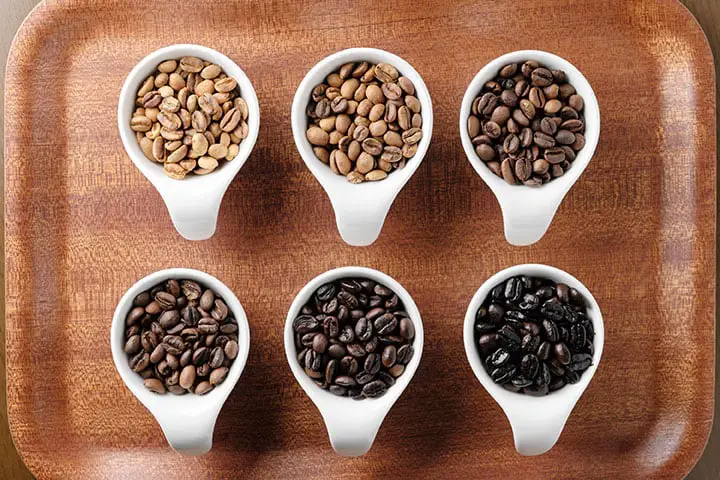
The roasting process can alter the caffeine content of coffee beans. This is because caffeine is soluble in water, and as the beans are roasted, the water inside them evaporates, causing the caffeine content to become more concentrated.
Light roasted coffee, such as a blonde roast, has a lower caffeine content compared to medium and dark roasted coffee. This is because light roasted coffee has a higher water content, and as a result, the caffeine is less concentrated. On the other hand, dark roasted coffee has a higher caffeine content due to the longer roasting time, which causes the water content to decrease and the caffeine to become more concentrated.
In addition to the roasting time, the type of coffee bean also affects the caffeine content. Arabica beans, for example, have a lower caffeine content compared to Robusta beans. This means that a cup of coffee made from Arabica beans will have less caffeine than a cup of coffee made from Robusta beans.
Another factor that affects the caffeine content of coffee is the brewing method. For example, espresso shots have a higher caffeine content compared to a cup of drip coffee because of the pressure and the short brewing time. French press and pour over coffee also have a higher caffeine content compared to drip coffee because of the longer brewing time.
The roasting process plays a significant role in determining the amount of caffeine in coffee. Light roasted coffee has a lower caffeine content, while dark roasted coffee has a higher caffeine content. The type of coffee bean and the brewing method also affect the caffeine content of coffee.
In the end, the amount of caffeine you want in your cup of coffee is a personal preference, and the best way to determine the right amount for you is to experiment with different roasts, beans, and brewing methods. Whether you prefer a light, medium, or dark roast, there is a coffee out there that will suit your taste and caffeine needs.
How Much Caffeine is in Pour Over Coffee?
The average eight-ounce cup of pour-over coffee contains about 145 milligrams of caffeine, whereas one average eight-ounce cup of French press coffee contains about 107.5 milligrams.
Percolated coffee is the most highly caffeinated variety of drip coffee, with the average eight-ounce cup containing a whopping 200 milligrams of caffeine.
That being said, keep in mind that many coffee shops serve their coffee using cup sizes that are larger than the standard serving size of eight ounces.
A Tall Starbucks drink is 12 ounces, a Grande is sixteen ounces, and a Venti is twenty ounces, which is two-and-a-half servings’ worth of coffee. Finally, the caffeine contents of individual cups of brewed coffee can vary based on the roast level, grind size, and type of bean.
Generally speaking, French press coffee has a higher caffeine content when made using coarsely ground dark roasted beans, and percolator coffee has a higher caffeine content when made using coarsely ground light roasted beans.
How Much Caffeine is in Espresso?
Of course, pour over coffee is not the only kind of coffee out there. Espresso, which is one of the other most popular types of coffee, is known for being heavily caffeinated.
It’s made by forcing a tiny amount of pressurized, boiling hot water through extremely fine coffee grounds, producing a thick, richly flavored liquid with a layer of foam, or crema, on top.
One serving of pure espresso measures just two fluid ounces, but many espresso drinks, like lattes, Macchiatos, Americanos, and flat whites, combine a shot or two of espresso with other ingredients like steamed milk, whipped cream, chocolate, hot water, and foam.
The average shot of espresso contains 150 milligrams of caffeine. This is approximately the same caffeine content as an eight-ounce cup of pour-over coffee.
You may be thinking, “I thought that espresso had more caffeine than brewed coffee!”
The answer? Yes and no.
One shot of espresso has about the same caffeine content as one eight-ounce brewed cup of coffee.
But, if you’re buying from a coffee shop like Starbucks, your cup of brewed coffee probably contains more caffeine than one shot of espresso. In that sense, a serving of espresso has less caffeine than a serving of regular coffee.
But, in terms of caffeine per ounce, espresso is definitely more heavily caffeinated. One ounce of average espresso contains 75 milligrams of caffeine, whereas one ounce of average drip coffee contains only 18 milligrams of coffee.
If you were to drink an eight-ounce cup full of pure espresso, you’d be consuming 600 milligrams of caffeine, which is equivalent to the caffeine in just over four cups of pour-over coffee.
How Much Caffeine is in Iced Coffee?
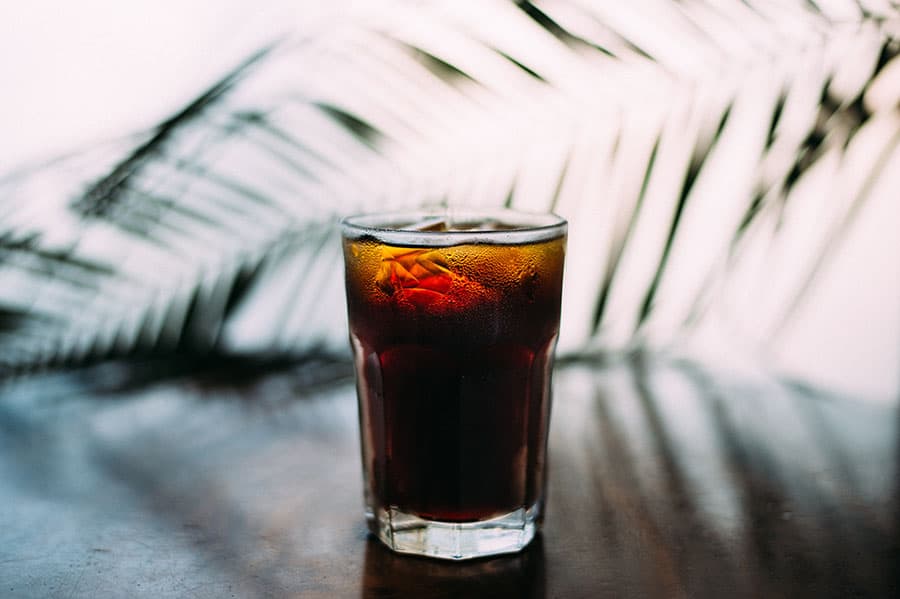
The caffeine content in iced coffee is not always the same as the caffeine content in hot coffee. Regular iced coffee is exactly the same as hot coffee, but poured over ice.
However, that ice takes up space in your cup, which means that a sixteen-ounce cup full of iced coffee doesn’t have as much actual coffee as an equivalent hot size, which also means that it doesn’t have as much caffeine.
For comparison purposes, a sixteen-ounce cup of hot coffee has about 290 milligrams of caffeine, whereas a sixteen-ounce cup of iced coffee has about 203 milligrams of caffeine, since about 30% of the cup is taken up by ice.
However, cold brew coffee is just as heavily caffeinated than hot coffee, since it uses an entirely different brewing process than iced coffee. Cold brew coffee is made by steeping coffee grounds in cold water for at least twelve hours.
The coffee-to-water ratio in cold brew is usually a little over double that of hot coffee, which means that more caffeine is extracted into the finished product. This higher caffeine content in cold brew makes up for the space taken up by ice, milk, and sweetener that dilutes regular iced coffee.
Is their Caffeine in Decaf Coffee?
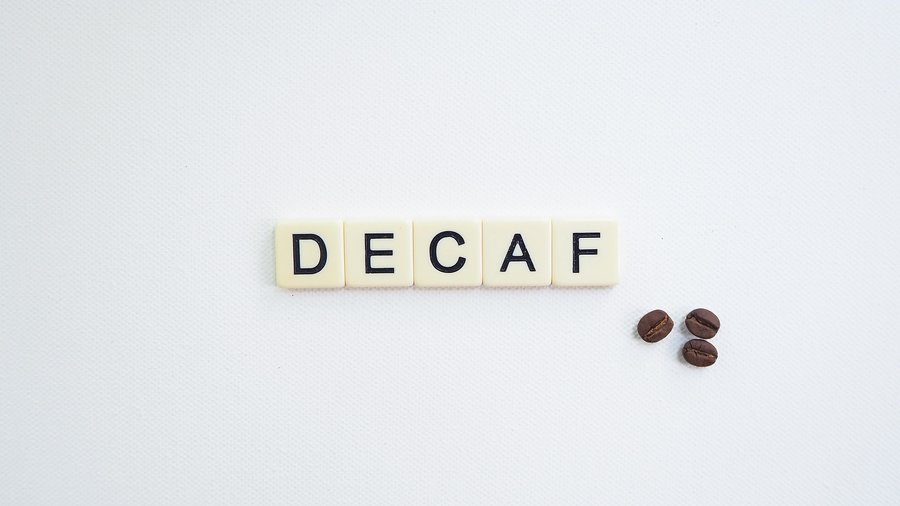
Now that we’ve explored the caffeine contents of different bean species, roasts, and brewing methods, let’s talk decaf coffee. Although decaf’s name suggests that it has had all of its caffeine removed, that’s not necessarily true.
The average eight-ounce serving of decaf coffee still contains up to seven milligrams of caffeine. This amount seems negligible compared to a serving of regular coffee, which can contain up to 200 milligrams of caffeine, but still, decaf coffee still has a little bit of caffeine.
If you were to drink ten cups of decaf, you’d end up consuming the same amount of caffeine as one cup of regular coffee.
There are several major methods to decaffeinate coffee, but all of them occur during the green coffee bean stage, before the beans get roasted. The Indirect-Solvent Based Process soaks green coffee beans in boiling water for several hours, which extracts most of the caffeine out of the beans, but also the flavor.
Then, the caffeinated water is mixed with chemical solvents like methylene chloride and ethyl acetate, which evaporate the caffeine out of the water. Then, the decaffeinated beans are reintroduced to the water, so that they can reabsorb the flavor they lost during the boiling process.
The Direct-Solvent Based Process rinses green coffee beans directly with methylene chloride or ethyl acetate for ten hours, which removes most of the caffeine. Finally, the Swiss Water Method, which is the only organic decaffeination method, uses boiling hot water and activated charcoal filters to remove the caffeine from green coffee beans.
Final Thoughts
As you can see, the world of caffeinated coffee is much wider and more complicated than you might have initially thought.
To wrap it up, if you’re looking to drink coffee that’s as highly caffeinated as possible, try a steaming hot cup of lightly-roasted, coarsely-ground Robusta beans prepared using a percolator.
If you’d rather drink iced coffee, make sure you’re ordering or making cold brew instead of regular iced coffee, which has a lower caffeine concentration. Finally, you could down a double shot of espresso, which has half the volume of one serving of coffee, but double the caffeine.

